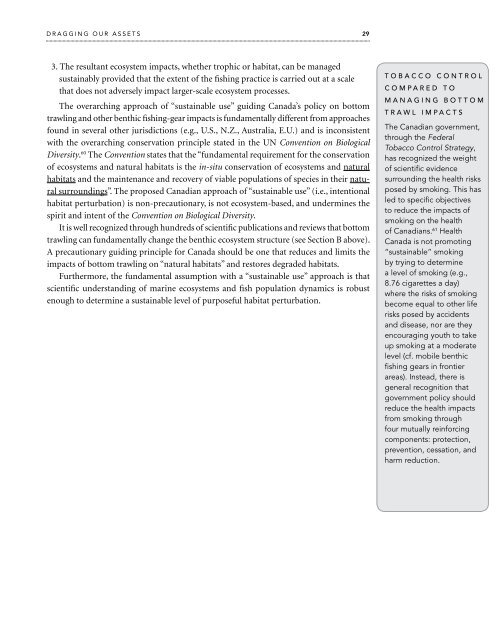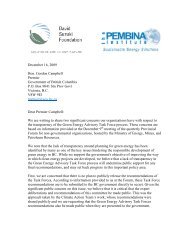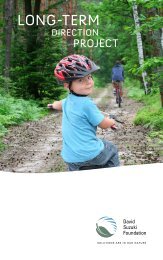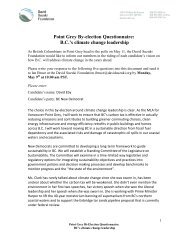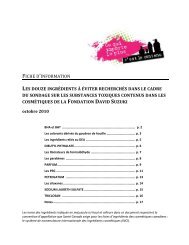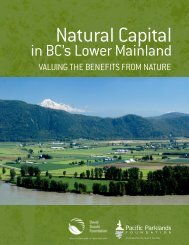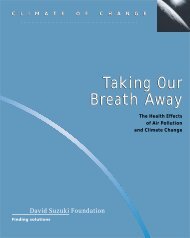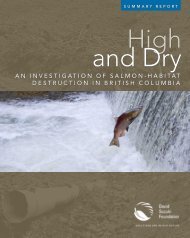Toward an Ecosystem Approach to Bottom Trawling in Canada
Toward an Ecosystem Approach to Bottom Trawling in Canada
Toward an Ecosystem Approach to Bottom Trawling in Canada
- No tags were found...
You also want an ePaper? Increase the reach of your titles
YUMPU automatically turns print PDFs into web optimized ePapers that Google loves.
DRAGGING OUR ASSETS293. The result<strong>an</strong>t ecosystem impacts, whether trophic or habitat, c<strong>an</strong> be m<strong>an</strong>agedsusta<strong>in</strong>ably provided that the extent of the fish<strong>in</strong>g practice is carried out at a scalethat does not adversely impact larger-scale ecosystem processes.The overarch<strong>in</strong>g approach of “susta<strong>in</strong>able use” guid<strong>in</strong>g C<strong>an</strong>ada’s policy on bot<strong>to</strong>mtrawl<strong>in</strong>g <strong>an</strong>d other benthic fish<strong>in</strong>g-gear impacts is fundamentally different from approachesfound <strong>in</strong> several other jurisdictions (e.g., U.S., N.Z., Australia, E.U.) <strong>an</strong>d is <strong>in</strong>consistentwith the overarch<strong>in</strong>g conservation pr<strong>in</strong>ciple stated <strong>in</strong> the UN Convention on BiologicalDiversity. 60 The Convention states that the “fundamental requirement for the conservationof ecosystems <strong>an</strong>d natural habitats is the <strong>in</strong>-situ conservation of ecosystems <strong>an</strong>d naturalhabitats <strong>an</strong>d the ma<strong>in</strong>ten<strong>an</strong>ce <strong>an</strong>d recovery of viable populations of species <strong>in</strong> their naturalsurround<strong>in</strong>gs”. The proposed C<strong>an</strong>adi<strong>an</strong> approach of “susta<strong>in</strong>able use” (i.e., <strong>in</strong>tentionalhabitat perturbation) is non-precautionary, is not ecosystem-based, <strong>an</strong>d underm<strong>in</strong>es thespirit <strong>an</strong>d <strong>in</strong>tent of the Convention on Biological Diversity.It is well recognized through hundreds of scientific publications <strong>an</strong>d reviews that bot<strong>to</strong>mtrawl<strong>in</strong>g c<strong>an</strong> fundamentally ch<strong>an</strong>ge the benthic ecosystem structure (see Section B above).A precautionary guid<strong>in</strong>g pr<strong>in</strong>ciple for C<strong>an</strong>ada should be one that reduces <strong>an</strong>d limits theimpacts of bot<strong>to</strong>m trawl<strong>in</strong>g on “natural habitats” <strong>an</strong>d res<strong>to</strong>res degraded habitats.Furthermore, the fundamental assumption with a “susta<strong>in</strong>able use” approach is thatscientific underst<strong>an</strong>d<strong>in</strong>g of mar<strong>in</strong>e ecosystems <strong>an</strong>d fish population dynamics is robustenough <strong>to</strong> determ<strong>in</strong>e a susta<strong>in</strong>able level of purposeful habitat perturbation.T o b a c c o C o n t r o lC o m p a r e d t oM a n a g i n g B o t t o mT r a w l I m p a c t sThe C<strong>an</strong>adi<strong>an</strong> government,through the FederalTobacco Control Strategy,has recognized the weigh<strong>to</strong>f scientific evidencesurround<strong>in</strong>g the health risksposed by smok<strong>in</strong>g. This hasled <strong>to</strong> specific objectives<strong>to</strong> reduce the impacts ofsmok<strong>in</strong>g on the healthof C<strong>an</strong>adi<strong>an</strong>s. 61 HealthC<strong>an</strong>ada is not promot<strong>in</strong>g“susta<strong>in</strong>able” smok<strong>in</strong>gby try<strong>in</strong>g <strong>to</strong> determ<strong>in</strong>ea level of smok<strong>in</strong>g (e.g.,8.76 cigarettes a day)where the risks of smok<strong>in</strong>gbecome equal <strong>to</strong> other liferisks posed by accidents<strong>an</strong>d disease, nor are theyencourag<strong>in</strong>g youth <strong>to</strong> takeup smok<strong>in</strong>g at a moderatelevel (cf. mobile benthicfish<strong>in</strong>g gears <strong>in</strong> frontierareas). Instead, there isgeneral recognition thatgovernment policy shouldreduce the health impactsfrom smok<strong>in</strong>g throughfour mutually re<strong>in</strong>forc<strong>in</strong>gcomponents: protection,prevention, cessation, <strong>an</strong>dharm reduction.


